Excerpts from Jim Conrad's
Naturalist Newsletter
entry dated August 12, 2022, issued from near Tequisquiapan, elevation about 1,900m (6200 ft), N20.565°, W99.890°, Querétaro state, MÉXICO
TECLACOTE VERBESINA
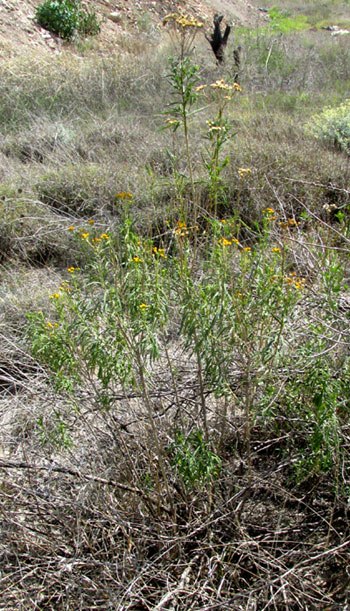 The rainy season, normally arriving here in May, now in August still hasn't arrived, so the landscape's vegetation cover remains largely dry-season gray and brown. Certain plants appear to be thriving, though, or at least dealing with it, and that's the case with the 2m tall (7ft), perennial shrub at the right, which is soft-woody at its base.
The rainy season, normally arriving here in May, now in August still hasn't arrived, so the landscape's vegetation cover remains largely dry-season gray and brown. Certain plants appear to be thriving, though, or at least dealing with it, and that's the case with the 2m tall (7ft), perennial shrub at the right, which is soft-woody at its base.
The plant grows in a much disturbed plot of abandoned land near a major highway where construction debris is dumped. The soil is eroded into shallow gullies. The weedy bush's clusters of small, yellow flowers offer visual relief in an otherwise desolate landscape. Its branch-tip inflorescences are shown below:
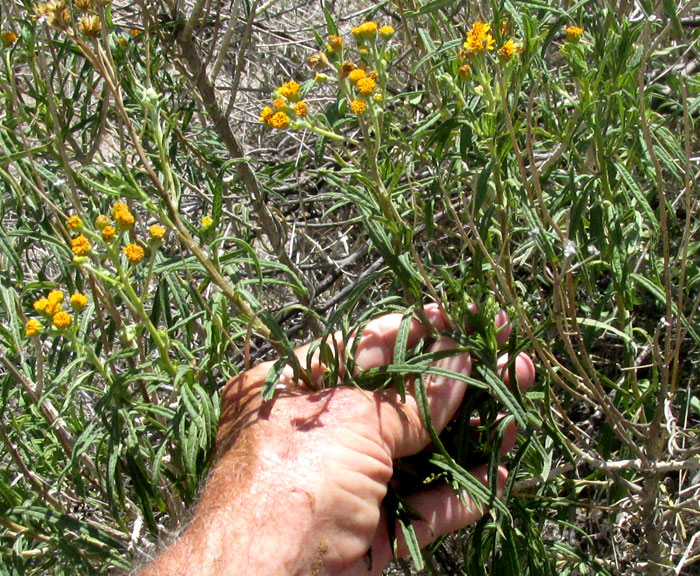
Even from this distance it's clear that the plant is a member of what's probably the most species-rich of all plant families, the Composite or Aster Family, the Asteraceae. The family's main field mark is that it gathers its very small florets into compact heads called capitula. The family's enormity often makes it hard to distinguish which of the ~23,600 species one might be dealing with. Above, important features to notice include the leaves being exceptionally slender, and arising singly along the stems, not with two or more leaves opposite one another.
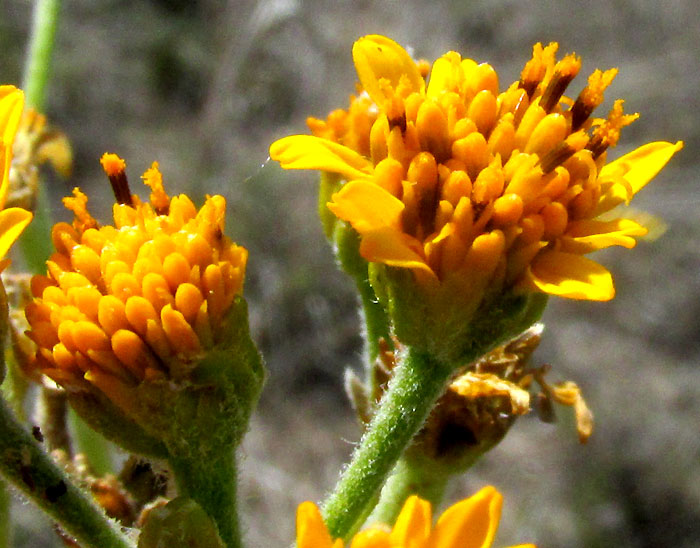
Up closer, other important details begin to emerge. In the capitula, both the flat, petal-like ray florets along the margins and the cylindrical disc florets in the centers are yellow. The ray florets are shorter than in many species. Many capitula on this plant produce no ray flowers at all, as seen on the picture's left side.
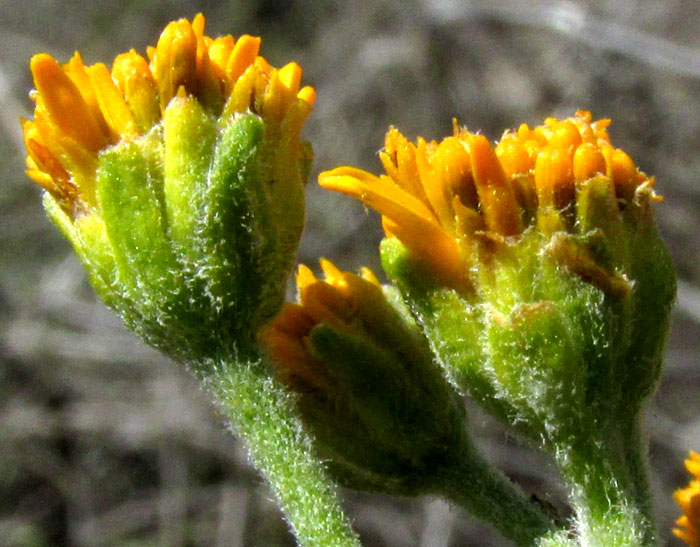
In the Aster Family, the green, cuplike structure at a capitulum's bottom, the involucre, consists of scale-like bracts, or phyllaries, which can exhibit many different shapes and sizes. Above it's seen that this species' phyllaries are rounded at their tips, they overlap, and they're hairy.
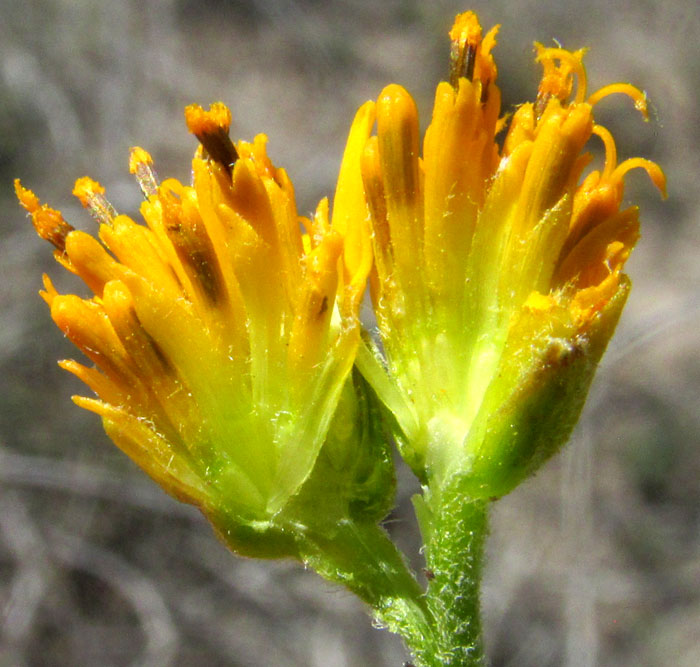
Breaking open a head, the most diagnostic feature seen is that each cylindrical floret is partially surrounded by a yellow, scoop-like structure called a palea. Certain "tribes" of the Aster Family produce no palea, so this single observation eliminates thousands of possible identities.
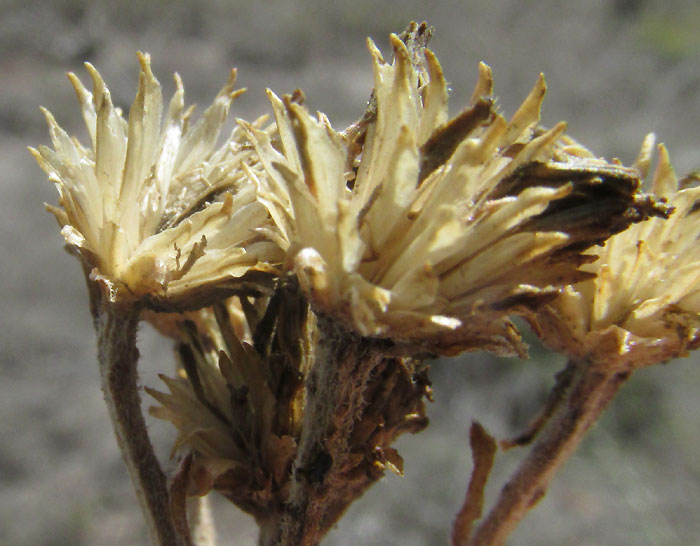
Fortunately, some of the previous season's dried-up capitula remained atop the plant. However, all the above picture shows is the dried-up phyllaries and palea. The dry, one-seeded, cypsela-type fruits already have been dispersed. Sometimes if you keep breaking open such capitula you'll find a fruit still in place. I smashed several in my hand and photographed the debris, hoping for some cypselae to show up. My old eyes couldn't see what was there, but when the images were reviewed on the laptop screen I saw what's shown below:
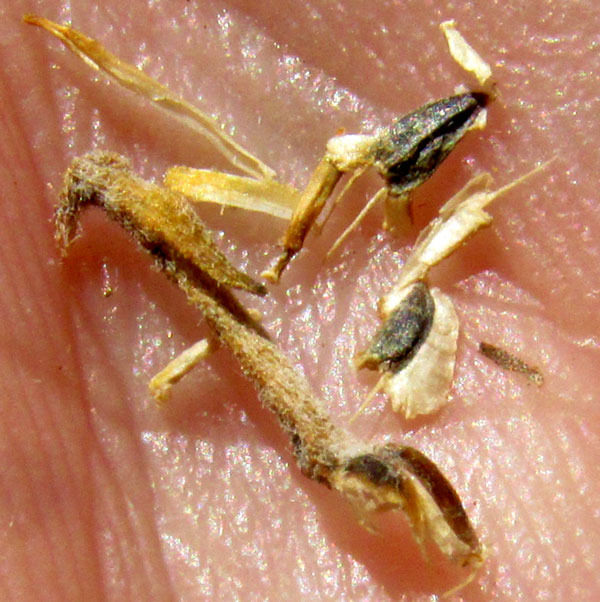
The two black items in the image's upper, right corner are cypsela-type fruits. The cypselae are flat and, diagnostically, the topmost one bears at its broad, flat top two slender, needle-like awns. One awn is broken from the lower cypselae. Knowing that our plant's flowers produce paleae and that its cypselae bear two, easily detachable awns at their tops is the most important information we've gathered. Now we know that our plants are members of the Aster Family's sunflower tribe, the Heliantheae.
The Aster Family is so vast that the Flora del Bajío, which treats plants in our Bajío region of upland central Mexico, publishes the family in different volumes. Not all the volumes are finished, but the Heliantheae is, and that tribe itself is so large that it spans three volumes. With the help of that, the above-mentioned features led us to the genus Verbesina, home to maybe 300 species or so, with 25 listed for our Bajío region. The genus Verbesina is well known to North American wildflower admirers, in English the various species often known as crownbeards, wingstems and by other names.
If you have a shrubby Verbesina in our area with very narrow leaves appearing singly along the stem, and the capitula containing fewer than 60 disc florets, the Flora says you have either Verbesina virgata or Verbesina oreopola. Our plant most corresponds to the description of the latter, but current consensus seems to be that V. oreopola is a synonym for V. virgata, so apparently our plant is just a low-elevation expression of VERBESINA VIRGATA.
Verbesina virgata is endemic to upland western and central Mexico, occurring mostly in oak and coniferous forests, especially disturbed ones, and arid scrub, between 1000-2900 m in elevation (~3250-9550 ft). Our plant bears no English name, but in Spanish it's known by several, with one of them consistently appearing in publications, which is Teclacote.
Teclacote is known among beekeepers as an exceptionally good source of nectar and pollen. Moreover, Z. Cano-Santana in a 1994 study entitled "La Reserva del Pedregal como ecosistema: estructura trófica," found that Verbesina virgata, more than any other plant in the Ecological Reserve of the Pedregal de San Ángel in Mexico City, contributed to the above-ground primary productivity. Above-ground primary productivity is an indicator of an ecosystem's ability convert solar energy into organic carbon, or biomass.
As such, Liliana Isabel Ruvalcaba-Sánchez and others in their 2009 study entitled "Estructura de la comunidad de invertebrados epífitos asociados a Verbesina virgata (Asteraceae)" found 235 morphologically distinct invertebrate species associated with our plant. Basically, grasshoppers, caterpillars, beetles and such ate the plant, spiders ate some of those species, etc. In other words, Verbesina virgata was an exceptionally important component of the reserve ecosystem simply because it was so edible to so many creatures who themselves were edible or in some other way useful to the ecosystem. The ecosystem itself provided oxygen for the Mexico City area, prevented erosion, and produced a host of other benefits to living things in general.